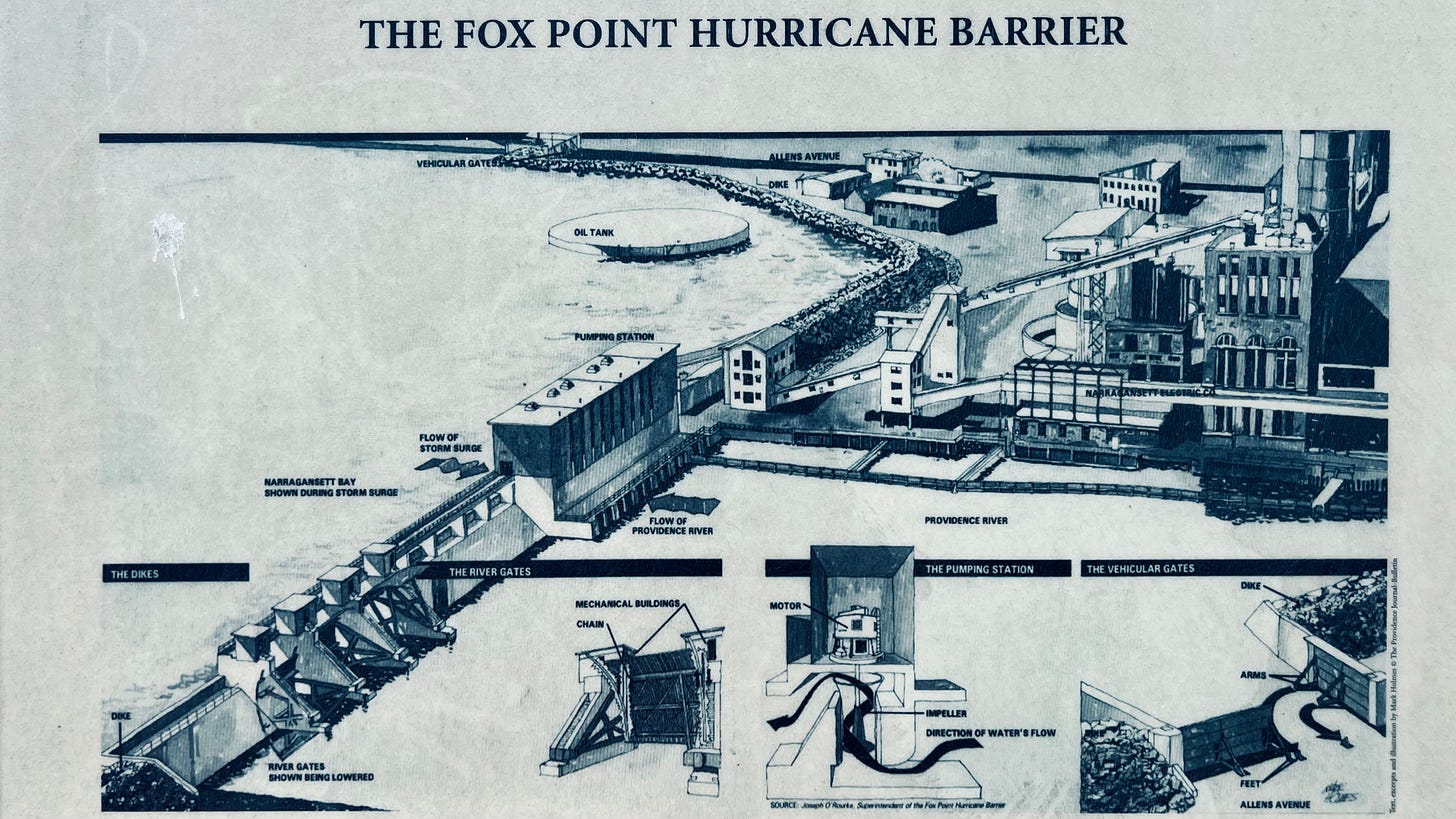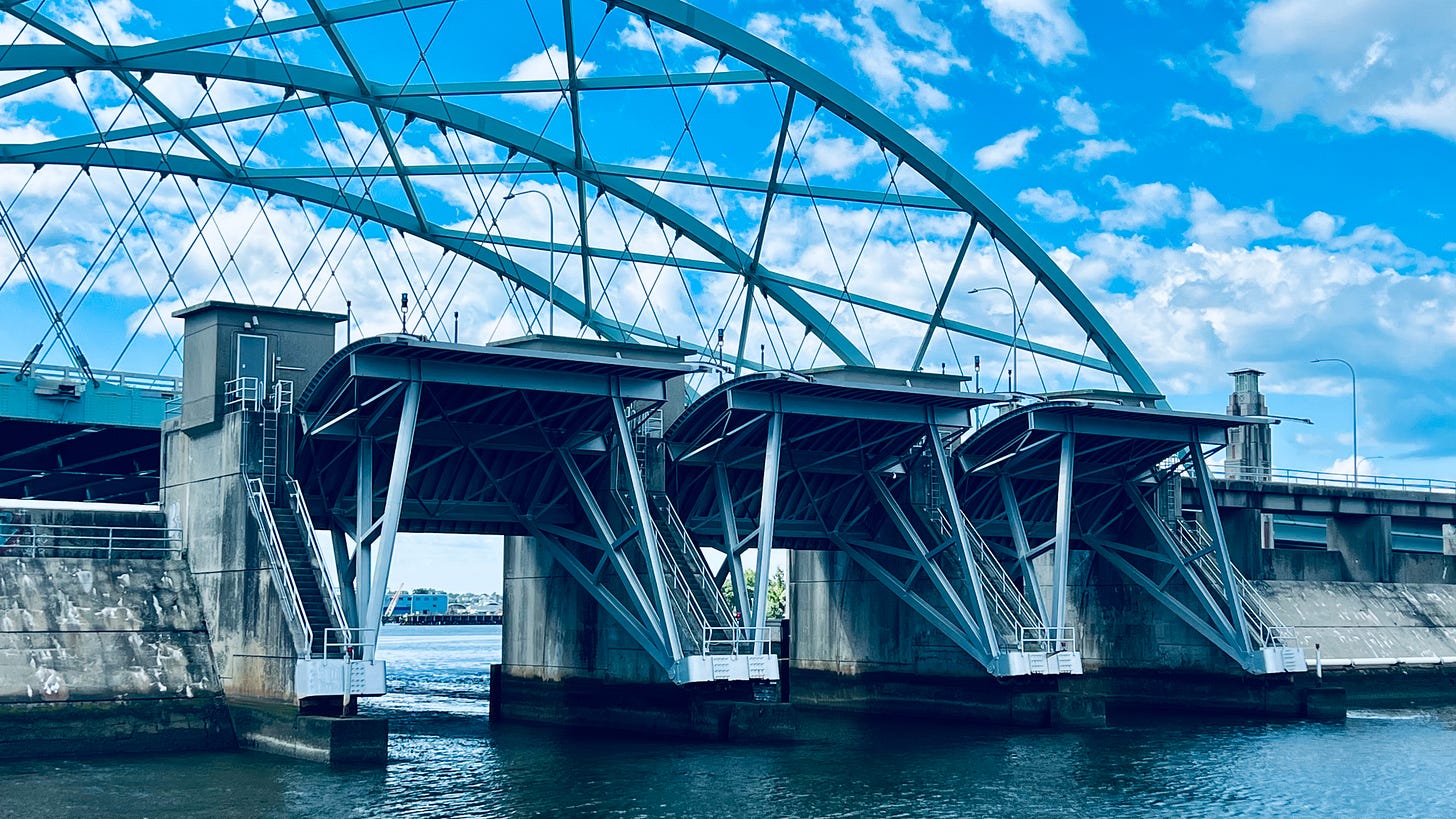Mayor Smiley announces preparations for hurricane season and extreme weather
"In the last year we have experienced a surge in both extreme heat and flash flooding, often in the same week, " said the Mayor.
Steve Ahlquist: On the other side of this barrier are South Providence and the Port of Providence. These areas are not protected by the barrier and are also some of the most polluted land in New England. In the event of a flood, that pollution will be spread all over those neighborhoods and even perhaps downtown if the barrier leaks. What is the plan to deal with the contamination that comes from flooding in the Port?
Providence Mayor Brett Smiley: The [Fox Point] Hurricane Barrier protects downtown. There's quite a bit of the city that's not protected by the hurricane barrier, and it should do its job to protect downtown, as [it was built in] response to the 1954 hurricane.
We have plans in place that [Providence Emergency Management Agency (PEMA) Director] Clara [Decerbo] can come up and share in just a second about any flooding that occurs elsewhere in the city. As she mentioned, we will be testing the Port Siren this Friday, so when folks hear that they should not be alarmed, that is only a test and that's part of our emergency notification system that we want to make sure is working properly.
But as for the city's flood mitigation plan, which I believe is open for public comment now, [Clara can] share the city's other flood plans.
Director Decerbo: The multi-Hazard Mitigation Plan has a large section that talks about flood mitigation efforts in the Port of Providence. We recognize that the Port of Providence is completely unprotected by the hurricane barrier, as is South Providence. One of the major pieces of the multi-hazard mitigation plan is looking comprehensively at impacts on our most vulnerable populations, including neighbors and neighborhoods outside the hurricane barrier, and also looking comprehensively, not just at the flood risk, but also at the health impacts of pollution and extreme heat, and taking a comprehensive look at the multiple factors that impact these vulnerable communities.
Right now, yes, a hurricane would cause massive damage and cause pollution, but there are other hazards that they're dealing with every day already, including nuisance flooding, street flooding, and extreme heat days that are extremely dangerous. We're trying to look comprehensively across all of the hazards impacting those vulnerable communities.
Steve Ahlquist: And that does take into account then the contamination in the area?
Director Decerbo: Yeah. It talks about the hazardous materials in the Port of Providence. It's also important to know that the companies that are in the Port of Providence are required to abide by EPA [Environmental Protection Agency] standards and EPA reports that include things like Tier Two reporting about their hazardous materials. They have to have plans in place and preparedness for things like flooding. It's something that we deal with with the local emergency planning committee, and we engage with the stakeholders in the Port of Providence around that.
Here’s the full press conference:
From the Mayor’s press release:
Mayor Brett PSmiley today joined Councilor Sue AnderBois and Providence Emergency Management Agency (PEMA) Director Clara Decerbo at the Fox Point Hurricane Barrier to highlight the investments Providence is making to mitigate the impact of extreme weather and share important safety information about high heat, flooding, and precautionary actions the public should take ahead of what is predicted to be an above-normal hurricane season.
"As a coastal city, the effects of climate change have had a tangible impact on our community and local businesses. In the last year we have experienced a surge in both extreme heat and flash flooding, often in the same week," said Mayor Brett Smiley. "That is why we are working across departments to make significant investments in our stormwater infrastructure and prioritizing initiatives and investments that build a more resilient city and protect our communities from natural disasters."
In response to the increase in extreme weather, Mayor Smiley is investing in innovative solutions that make Providence more sustainable and less vulnerable to the impacts of extreme weather. These investments include funds for critical repairs to the Providence Hurricane Barrier and enhancements to stormwater and sewer systems to better manage the increased volume of severe storms and flash floods. For months the Providence Department of Public Works crews have been proactively dredging canals to increase the City's stormwater capacity and in the recently signed FY25 budget, there is a nearly $136,000 allocation for a dedicated sewer team to further support flood mitigation.
“As we look forward to summer, we are preparing for another year with increasingly intense storms and high temperatures. We've already experienced our first 'heat dome', with temperatures exceeding 90 degrees in June,” said Sue AnderBois, Ward 3 City Councilmember and Chair of the Council Special Committee on the Environment and Resiliency. "The Council and Administration are working actively together to ensure that we are prepared both for this summer - and longer term for long-term effects of climate change. From investments and planning around stormwater management and flooding on our roadways and in homes and businesses to opening and operating cooling water features in our parks and recreation centers - we want to ensure that our residents are staying cool and staying safe in extreme weather in every neighborhood. Please check on your neighbors and also report any major issues to 311 and your City Councilor."
The Smiley Administration is also establishing a network of Resiliency Hubs, spaces In recreational centers and community-centered facilities that are designed to provide wrap-around services year-round, address environmental inequities, and support the community during extreme weather events.
The Olneyville Resiliency Hub, the City's first pilot Resiliency Hub, launched earlier this year at the Joslin Recreation Center. Staff at the Resiliency Hub coordinate community health activities and educational services and the hub will soon serve as a cooling or heating center during extreme weather events. Last month in response to high heat, the Smiley Administration activated the City's cooling centers and opened water parks two weeks early to provide relief for community members during the heat wave.
“The Providence Emergency Management Agency is working collaboratively with Mayor Smiley and other City Departments to better prepare and protect our community from the rise of extreme weather events and what is anticipated to be an above-normal hurricane season,” said PEMA Director Clara Decerbo. “It is important for our community and local businesses to be informed about the resources available to them and the precautionary steps that should be taken to prepare for severe weather, including high heat, flash flooding, and hurricanes. I encourage all of our neighbors to monitor the City of Providence's social media for updates on heat and extreme weather advisories."
PEMA is constantly monitoring national weather trends and urges the public to be aware of the dangerous forecasts predicted for this year's hurricane season. According to recent National Oceanic and Atmospheric Administration (NOAA) and Colorado State University predictions, this year could bring as many as 25 named storms.
PEMA is encouraging community members to stay informed and take proper precautions to protect themselves and their families from extreme heat, flooding, and hurricanes including:
Signing up for CodeRED and PVD311 alerts to stay informed on the latest extreme storm alerts.
To prepare for a hurricane, create an emergency plan and learn about evacuation routes.
Learn more about the Providence Cooling Center locations near you to prepare for extreme heat.
During a flood, remember to avoid flood-prone streets by rivers, clear debris from your storm drains, and do not enter closed or flooded streets. More information on flooding can be found here.
For further information on Hurricane preparedness and evacuation tips, visit the FEMA website.
According to the draft Hazard Mitigation Plan, the “entire City of Providence is at risk of CBRNE [Chemical, Biological, Radiological, Nuclear, and high-yield Explosives] and hazardous material release incidents.”
According to the report, areas of heightened concern include:
Port of Providence: The Port of Providence (Prov Port) is one of America’s most strategically located port facilities. Currently operated by Waterson Terminal Services, the Port is located at the convergence of Narragansett Bay and the Providence River. The Port’s campus is more than 105 acres, and the facility offers more than one mile of linear berthing, capable of working six vessels at any one time. As one of New England’s only deep water operations, Prov Port has an on-dock rail with three rail spurs, 20 acres of open lay down area, 300,000+ square feet of enclosed warehouse facilities, is adjacent to pier face and on-dock rail lines and has fixed and mobile cranes available. Prov Port provides both domestic and international bulk, break bulk, and project cargo clients. Tankers arriving at the Port provide fuel for Rhode Island, as well as Southeastern Massachusetts, Cape Cod, and northern Connecticut. The Port is also the main entry for the bulk of home heating fuel and motor fuels for the New England region, and has a major Liquified Natural Gas (LNG) storage and transfer facility; 8.5 million gallons of liquid ethanol is transported through the Blackstone Valley via cargo trains each year and blended at the port terminals for distribution. Prov Port is a critical economic engine for New England, with an estimated $200 million total economic impact on the region. The port is host to more than a dozen companies. Combined, the activities at Prov Port provide more than $60 million in direct business revenues and $16 million in revenue to local and state governments.
Tier I and Tier II Facilities: Several facilities in the City of Providence store, use, dispose of, or handle hazardous materials regularly. These facilities are classified as “Tier I” or “Tier II” facilities regulated by Title III of the Emergency Planning and Community Right-to-Know Act (EPCRA).
Liquified Natural Gas (LNG) and Liquefied Petroleum Gas (LPG) Storage Facilities:
The LNG facility stores 600,000 barrels of LNG - a cryogenic gas that is cooled to -260°F for storage. It is primarily methane with a flammable range between 5 and 15 percent in air. When used, the temperature is elevated, and the liquefied gas expands 600 times and is transported to homes and businesses via the gas main system for commercial use. The tank is filled during the summer months for winter use by trucks coming from the LNG facility in Everett, Massachusetts. The tank is diked to contain a liquid leak equal to one and a half times the capacity of the tank. The facility is hazardous as in the case of a leak, the liquid would eventually heat up and migrate from the diked area until it contacted an ignition source where it would ignite and flashback to the diked area, igniting the rest of the pool and causing an extremely intense fire beyond the capabilities of any municipal fire department.
The LPG facility is located approximately one mile away from the LNG facility. The LPG facility contains 400,000 barrels of LPG. LPG is a gas cooled to -44°F, with an expansion ratio of 270 to 1, and is mainly propane. The flammable range is between 2 to 9 percent in air. The LPG facility is also approximately 500 feet from the largest chemical storage company in the city. LPG is used commercially for heating and is distributed under pressure via truck. LPG is brought to the city via ship. The facility receives approximately 12 deliveries annually. The main hazard of propane is that it is heavier than air, and should a leak occur, the gas will seek an ignition source and flash back to the container. [Note: LPG is propane.]







Maybe better than most places, but not good enough
Trusting companies to abide by EPA standards has not worked well for usin the past and VERY unlikely given recent rulings (Chevron) to work well for us in the future!